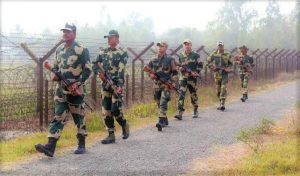The Indian government plans to deploy bee warriors to check criminal activities along its border with Bangladesh.
It has decided to install beehives on the India-Bangladesh border fence to curtail cattle smuggling and other crimes such as drug peddling and infiltration. The effort is also aimed at generating livelihood for the local populace.
The project has been launched first in Nadia district in the border state of West Bengal by the Border Security Force (BSF), which is tasked to guard the border. The beehives on the fence are expected to prevent smugglers from punching holes in the fence as any such effort will trigger an attack by the bees and injure them.
A senior BSF officer was quoted by the media as saying that the bee boxes would be placed above the ground near flowering plants and a shade over them to create a natural habitat.
In addition, the BSF will also focus on growing medicinal plants along the border to help the local populace generate additional income. The Ministry of Ayush has provided the paramilitary force with saplings of tulsi, ekangi, satmuli, ashwagandha and aloe vera, which have a high demand in the market. The medicinal plants will be an added source for the bees to pollinate.
The BSF will market the medicinal plants and honey from the beehives and villagers will benefit monetarily. The ministry will also collect the produce to prepare herbal products.
The India-Bangladesh border spans a distance of 2,520 miles and passes through hilly terrain, rivers and flat landscapes. The new initiative comes in the backdrop of efforts by the Indian government to curb cross-border criminal activities and to complete the fence, which is still unfinished in a large stretch.
The fence is yet to be erected in five districts— Malda, Murshidabad and Cooch Behar in West Bengal; Karimganj in Assam; and West Jaintia Hills in Meghalaya — along the border owing to problems such as land acquisition and relocation of villages. The home ministry’s annual report last year mentioned that the unfenced portion of around 591 miles would be fenced by March 2024. However, the prospects of meeting that deadline seem dim, according to some reports.
The government has also firmed up plans to increase floodlighting, border outposts, integrated check posts and roads within a specific timeframe. A 38-mile-long smart fence has been set up as well in Assam’s Dhubri, where the presence of numerous sandbars and river channels makes the task of policing difficult for the BSF.
Smugglers regularly breach the fence to ferry the contraband items. The BSF has also found tunnels.
A range of commodities are traded illicitly across the entire stretch of the border. According to an estimate in 2014, informal exports from India to Bangladesh were about $4 billion, which is almost the same as the volume of formal trade. A section of government officials believe that the volume has grown over the past few years with more commodities being included in the list.
An official in India’s home ministry told The Diplomat that while the process of installing beehives in West Bengal has started, a similar exercise would begin in the other four states that share borders with Bangladesh. “Locations suitable for the beehives are being identified currently with a focus on the 163-mile border in Assam. Certain criteria would be followed while implementing the scheme which must also have an impact on the neighboring villages,” he said.
The new scheme is being executed under the “Vibrant Village Programme,” which is also being implemented along India’s border with China, where 168 villages are being connected by road and other forms of connectivity. The scheme was launched to prevent the residents of the border villages from abandoning their homes and relocating to places that have better connectivity.
Barring some sections in the northeastern states of Tripura and Mizoram, the India-Bangladesh border does not suffer from connectivity glitches. The greatest challenge for the government on this border is to check crimes for which the cooperation of the local populace has been deemed essential.

































